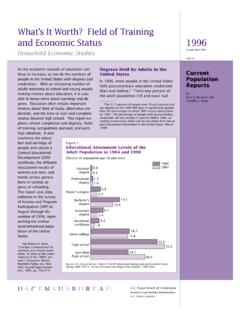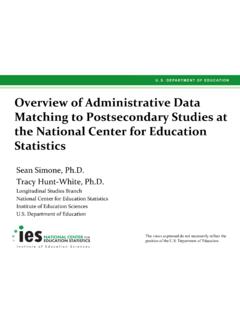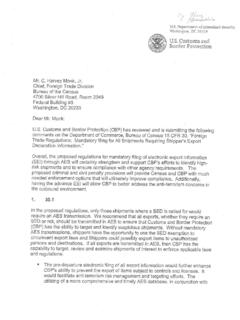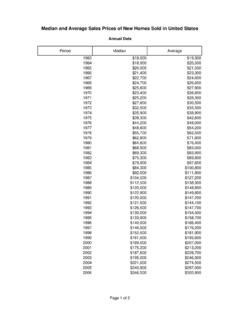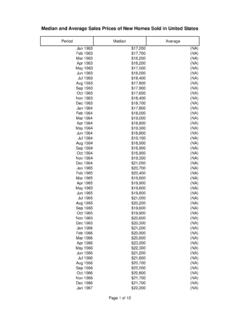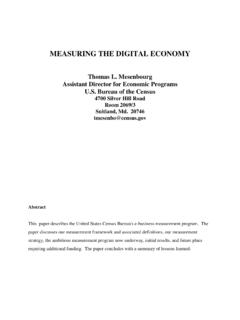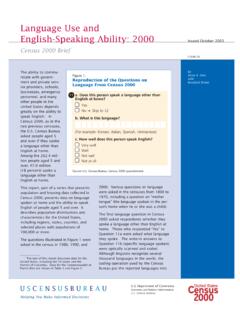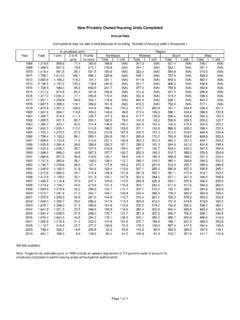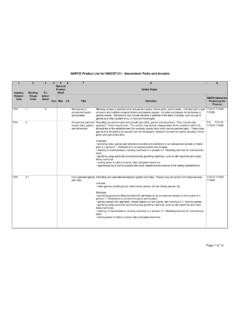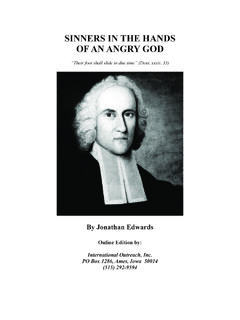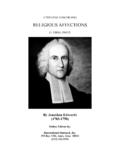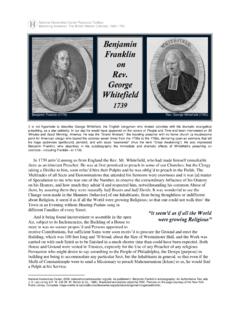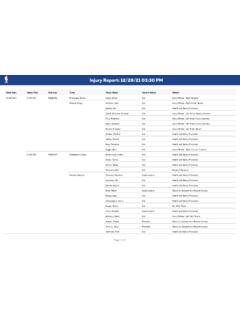Transcription of Current Population Reports
1 Issued September 2020 Revised September 2021P60-270 (RV)By Jessica Semega, Melissa Kollar, Emily A. Shrider, and John F. CreamerIncome and Poverty in the United States: 2019 Current Population ReportsAcknowledgmentsThe Social, Economic, and Housing Statistics Division of the Census Bureau recognizes Bernadette D. Proctor for her 26 years of service contributing to the poverty section of the Current Population Reports , Series P-60. Ms. Proctor moved to a new position within the Census Bureau in 2019. The division and the many data users who relied on her outstanding customer service will miss her experience, dedication, and good Semega and Melissa Kollar prepared the income section of this report under the direction of jonathan L. Rothbaum, Chief of the Income Statistics Branch. Emily A. Shrider and John F. Creamer prepared the poverty section under the direction of Ashley N. Edwards, Chief of the Poverty Statistics Branch. Trudi J.
2 Renwick, Assistant Division Chief for Economic Characteristics in the Social, Economic, and Housing Statistics Division, provided overall Ashton, Mallory Bane, and Susan S. Gajewski, under the supervision of David Watt, all of the Demographic Surveys Division, and Lisa P. Cheok of the Associate Directorate for Demographic Programs, processed the Current Population Survey 2020 Annual Social and Economic Supplement (CPS ASEC) Chen, Kirk E. Davis, Raymond E. Dowdy, Lan N. Huynh, Chandararith R. Phe, and Adam W. Reilly programmed and produced the historical, detailed, and publication tables under the direction of Hung X. Pham, Chief of the Tabulation and Applications Branch, Demographic Surveys Hood and Alfred G. Meier, under the supervision of KeTrena Phipps and David V. Hornick, all of the Demographic Statistical Methods Division, conducted statistical P. Cheok of the Associate Directorate for Demographic Programs, provided overall direction for the survey implementation.
3 Roberto Cases of the Associate Directorate for Demographic Programs, and Charlie Carter and Agatha Jung of the Information Technology Directorate prepared and programmed the computer-assisted interviewing instrument used to conduct the CPS people within the Census Bureau also made significant contributions to the preparation of this report. Brian Glassman, Gloria G. Guzm n, Matthew Marlay, Abinash Mohanty, Lindsey Monte, jonathan Vespa, and Lewis Warren reviewed the T. Beasley, Faye E. Brock, Christine E. Geter and Stephen V. Gibson provided publication management, graphics design and composition, and editorial review for print and electronic media under the direction of Janet Sweeney, Chief of the Graphic and Editorial Services Branch, Public Information Office. William A. Burbano and George E. Williams of the Census Bureau s Administrative and Customer Services Division provided printing Bureau field representatives and telephone interviewers collected these data under extreme circumstances.
4 The additional challenge of obtaining inter-views during the COVID-19 pandemic increased the difficulty of this task. Without their dedication, the preparation of this report or any report from the Current Population Survey would be Department of Commerce Wilbur Ross, SecretaryKaren Dunn Kelley, Deputy CENSUS BUREAU Steven Dillingham, DirectorP60-270 (RV)Income and Poverty in the United States: 2019 Issued September 2020 Revised September 2021 Suggested Citation Semega, Jessica, Melissa Kollar, Emily A. Shrider, and John F. Creamer Census Bureau, Current Population Reports , P60-270 (RV), Income and Poverty in the United States: 2019, Government Publishing Office, Washington, DC, CENSUS BUREAU Steven Dillingham, Director Ron Jarmin, Deputy Director and Chief Operating OfficerVictoria A. Velkoff, Associate Director for Demographic ProgramsDavid G. Waddington, Chief, Social, Economic, and Housing Statistics Census Bureau Income and Poverty in the United States: 2019 iiiContentsTEXTINTRODUCTION.
5 1 Summary of Findings .. 1 INCOME IN THE UNITED STATES .. 1 Highlights .. 1 The Impact of the Coronavirus (COVID-19) Pandemic on the CPS ASEC .. 2 Household Income.. 2 Type of Household .. 3 Race and Hispanic Origin .. 3 Caution for Historical Comparisons .. 3 Age of Householder .. 5 Nativity .. 6 Region .. 6 Residence .. 6 Income Inequality .. 6 Equivalence-Adjusted Income Inequality .. 7 Earnings and Work Experience .. 9 POVERTY IN THE UNITED STATES .. 12 Highlights .. 12 Race and Hispanic Origin .. 15 Sex .. 15 Age .. 16 Nativity .. 17 Region .. 17 Residence .. 17 Work Experience .. 17 Disability Status .. 17 Educational Attainment .. 18 Families .. 18 Depth of Poverty .. 18 Ratio of Income to Poverty .. 18 Income Deficit .. 19 ADDITIONAL INFORMATION ON INCOME AND POVERTY .. 19 State and Local Estimates of Income and Poverty .. 19 Longitudinal Estimates.
6 20 The Supplemental Poverty Measure (SPM) .. 20 Interagency Technical Working Group on Evaluating Alternative Measures of Poverty .. 21 SOURCE AND ACCURACY OF THE ESTIMATES .. 21 Comments .. 22iv Income and Poverty in the United States: 2019 Census BureauFIGURESF igure 1. Median Household Income and Percent Change by Selected Characteristics .. 4 Figure 2. Real Median Household Income by Race and Hispanic Origin: 1967 to 2019 .. 5 Figure 3. Income Distribution Measures and Percent Change Using Money Income and Equivalence- Adjusted Income .. 8 Figure 4. Median Earnings and Percent Change by Work Status and Sex .. 9 Figure 5. Female-to-Male Earnings Ratio and Median Earnings of Full-Time, Year-Round Workers 15 Years and Older by Sex: 1960 to 2019 .. 10 Figure 6. Total and Full-Time, Year-Round Workers 15 Years and Older With Earnings by Sex: 1967 to 2019 .. 11 Figure 7. Number in Poverty and Poverty Rate: 1959 to 2019.
7 12 Figure 8. Poverty Rate and Percentage Point Change by Selected Characteristics: People .. 13 Figure 9. Poverty Rate and Percentage Point Change by Type of Family : Families and People .. 14 Figure 10. Poverty Rates by Age and Sex: 2019 .. 15 Figure 11. Poverty Rates by Age: 1959 to 2019 .. 16 Figure 12. People With Income Below Specified Ratios of Their Poverty Thresholds by Age .. 19 Figure C-1. Historical Median Income Using Alternative Price Indices: 1967 to 2019 .. 76 AppendixesAppendix A. Estimates of Income .. 23 How Income Is Measured .. 23 Annual Average Consumer Price Index Research Series (CPI-U-RS) Using Current Methods All Items: 1947 to 2019 .. 24 Business Cycles .. 24 Cost-of-Living Adjustment .. 24 Poverty Threshold Adjustment and Historical Income Series .. 25 Appendix B. Estimates of Poverty .. 55 How Poverty Is Calculated .. 55 Poverty Thresholds for 2019 by Size of Family and Number of Related Children Under 18 Years.
8 55 Weighted Average Poverty Thresholds in 2019.. 56 Appendix C. Historical Income Alternative Inflation Series .. 75 References .. 77 Appendix D. Additional Data and Contact .. 80 Customized Tables .. 80 Public Use Microdata .. 80 CPS ASEC .. 80 Taxes and Noncash Benefits .. 80 Census Data API.. 80 Technical Documentation .. Census Bureau Income and Poverty in the United States: 2019 vAPPENDIX TABLEST able A-1. Income Summary Measures by Selected Characteristics: 2018 and 2019 .. 26 Table A-2. Households by Total Money Income, Race, and Hispanic Origin of Householder: 1967 to 2019 .. 27 Table A-3. Income Distribution Measures Using Money Income and Equivalence-Adjusted Income: 2018 and 2019 .. 37 Table A-4. Selected Measures of Household Income Dispersion: 1967 to 2019 .. 38 Table A-5. Selected Measures of Equivalence-Adjusted Income Dispersion: 1967 to 2019 .. 45 Table A-6.
9 Earnings Summary Measures by Selected Characteristics: 2018 and 2019 .. 51 Table A-7. Number and Real Median Earnings of Total Workers and Full-Time, Year-Round Workers by Sex and Female-to-Male Earnings Ratio: 1960 to 2019 .. 52 Table B-1. People in Poverty by Selected Characteristics: 2018 and 2019 .. 57 Table B 2. Families and People in Poverty by Type of Family: 2018 and 2019 .. 58 Table B-3. People With Income Below Specified Ratios of Their Poverty Thresholds by Selected Characteristics: 2019 .. 59 Table B-4. Income Deficit or Surplus of Primary Families and Unrelated Individuals by Poverty Status: 2019 .. 60 Table B-5. Poverty Status of People by Family Relationship, Race, and Hispanic Origin: 1959 to 2019 .. 61 Table B-6. Poverty Status of People by Age, Race, and Hispanic Origin: 1959 to 2019 .. 67 Table B-7. Poverty Status of Families by Type of Family: 1959 to 2019.
10 73 Table C-1. Historical Median Income Using Alternative Price Indices: 1967 to 2019 .. Census Bureau Income and Poverty in the United States: 2019 1 Income and Poverty in the United States: 2019 INTRODUCTIONThe Census Bureau collects data and publishes estimates on income and poverty in order to evaluate national economic trends and to understand their impact on the well-being of households, families, and individuals. This report presents data on income and poverty in the United States based on information col-lected in the 2020 and earlier Current Population Survey Annual Social and Economic Supplements (CPS ASEC) conducted by the Census This report provides estimates for calendar year 2019, the last year of the economic expansion spanning from June 2009 through February 2020. The data collection period for the 2020 CPS ASEC coincided with the COVID-19 pandemic, the associated public health response, and the end of the economic expansion.
